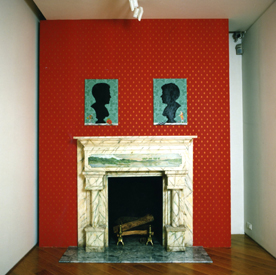
March 27 - May 29, 1998 |
McDERMOTT & McGOUGH
|
EUROPA THE LUST THAT COMES FROM NOTHING
|
galerie jerome de noirmont
|

exhibition release
AN ART-HISTORICAL ALCHEMY
« All time exists at the same time » ...
The art of MacDermott & McGough establishes a simultaneous link between Present and Past. They consider time indications as a pure invention of human mind and therefore as non-existing. « The present and steadfast Laws of Time, as they relate to our understanding of God through Religion, will certainly deconstruct as Mankind braves to claim the supposed movement of the solar year within this manipulative Capabilities ; however if Science continues to subscribe to the biblical linear Time Theory, which includes the prosaic notion that the Past does no longer exist, the Future is yet to be contrived and the Present is the only Relevance ».
David MacDermott & Peter MacGough refuse to accept the contemporary time frame and live in what they see the most favourable period, namely the end of the nineteenth century and the beginning of the twentieth century : their houses, often without electricity, and their studios are solely equipped with authentic objects from the past century ; they wear period clothes, cadged here and there ; when crossing the Atlantic they always travel by passenger boat... The use of retro language and of ancient penmanship is not for them, as for many others, a reaction against progress as an inexorable evolutionist tendency. MacDermott & MacGough live the Past as an existential provocation.
Just like their way of life, their photographic and painted work shows us their total refusal to live in the historical present.
Their obsession with the historical past extends to the subjects and styles they choose to ressurrect in their canvases and photographs, and the precise and fictitious dates they inscribe on their art (1889, 1908, 1923)...
The photographs, for which they make use of the techniques of the past century pioneers , developped in numerous nuances of sepia, give a perfect reflection of the atmosphere which must have prevailed during the shootings in those days. Thanks to the long exposure time, the pictures are very detailed and show a fineness in gradations which has never been equalled since then, that might even fill you with nostalgia of this period.
The world of MacDermott & MacGough is embedded in Dandysm. The result is an oeuvre that is supported by a structuralized substructure in which decorative inventions of the past play an important role. From their encyclopedic knowledge of art history, they draw unexpected, though well-chosen items, which they can fit into their structuralized and even geometrical patterns. Their litterary background provides them with textual motives and visual images which support the contents of their work.
The narrative character of their work is translated into paradoxes, because of the alienation of reality. For example, the sometimes designish links with words which were copied from advertisements, go beyond their mere advertising meaning.
In all, MacDermott & MacGough turn the cultural inheritance into a post surrealist panorama in which they have allocated -at least for themselves- an important part to homo-eroticism. The fantasized history of a gay subculture in America is a constant inspiration to the artist couple´s reconstruction of homosexual desire repressed by the convoluted rituals of nineteenth and early twentieth century decorum.
From raw souvenir of teenage awakening revealating an eruption of homosexual yearning at its most criminalized form in Peep Hole , a 1988 oil on linen, to more complex Victorian narratives, or even post-surrealist dream images, gay desire is a constant pattern in the work of MacDermott & MacGough. It can even be integrated into the world of popular entertainment, as in the Erotic Circus of 1900, a canvas where the local strong man, in full frontal nudity, lifts his muscular weight by supporting himself with two firm grips upon the erect penises, one black, one white, of two local clowns, within the gawdy pageantry of a circus. This X-rated fantasy, which could be easily as torrid as a pornographic work, emerges with an old-fashioned aura of Victorian innocence, a delicious irony explained this way : « If women desire to see the show perhaps it is fine for them ; perhaps it is wrong for us to show them the show. Anyway no man or boy child could take offense at such amazing sensational skill and fun. »
This gay desire, couched in antiquated rhetoric, defines in MacDermott & MacGough´s art a new type of classicism, where idealized beauty prevails. They create an imaginary world in an elegant erotic style, it denotes a new and admiring attitude towards religious iconography in which one could recognize reminiscences of Florentine mannerism in Renaissance altarpieces.
« We are not collectors of the past, we are only interested in producing a radical change in society. Careful though : we substitute the term radical with christian. The "radicals" of today do not understand that secret lies right in the world Christian. Christ was a radical figure because he never tried to adapt himself. He wanted to distinguish himself. »
As we can see in their Advertising Portrait 1908, it reads in the bold and clear letters of the original Sears Roebuck catalogue guarantee from which it was copied :
« WE MUST FURNISH A QUALITY OF MERCHANDISE THAT WILL EFFECTIVELY DISPROVE EVERY ARGUMENT OF EVERY KIND RAISED AGAINST US »









